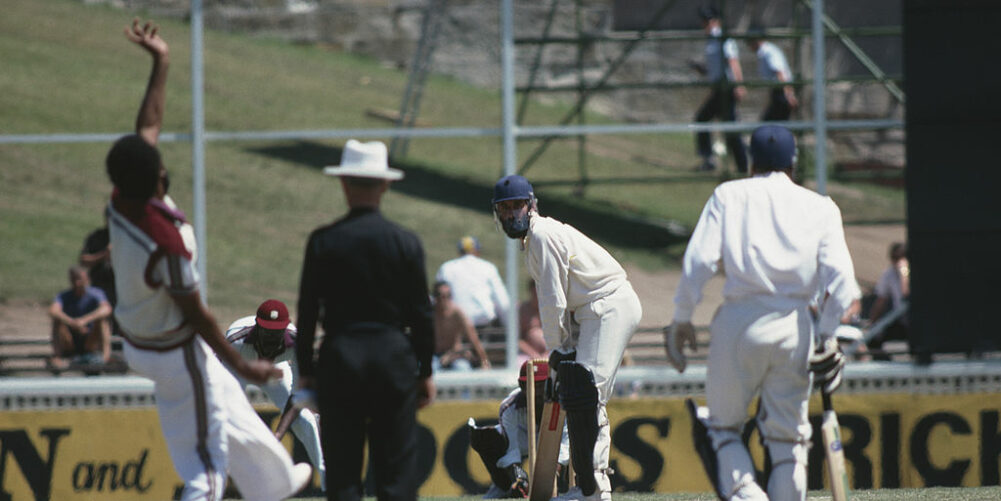By Derek Pringle
For those doubting the destructive power of a cricket ball to damage, both physically and psychologically, look no further than Luke Fletcher, the Nottinghamshire Outlaws bowler whose season was ended after he was struck on the head during a T20 match against the Birmingham Bears.
Fletcher, unusually, suffered the injury while bowling – his first ball of the match hit back at him by Sam Hain with such force that he was unable to take evasive action. It isn’t the first time a bowler has been clobbered this way and with batsmen wielding better rebounding bats with more intent now, it won’t be the last, though, mercifully, such injuries remain rare.
Cricket balls are made of leather, weigh five-and-a-half ounces and are hard. Being hit by one, especially at high speed, can break both a player’s bones and their spirit, which is why fast bowlers use them to threaten physical injury and to intimidate batsmen into giving up their wicket.
Better protective equipment like helmets, chest guards and arm protectors, along with those hardy perennials, gloves and pads, have reduced that physical threat though it has not disappeared entirely as the sad, untimely death of Phillip Hughes reminds us.
Hughes was struck by a bouncer during a Shield match at the Sydney Cricket Ground in 2014. The ball missed his helmet but not the artery that lies close to the surface between the back of the ear and the base of the skull. It was freakish but fatal and blame is still being sought.
Hughes’ death forced cricket to review its aggressive practices as well as its safety protocols though it wasn’t so long ago that batsmen routinely suffered for their art. Who present, for example, can forget the battering Robin Smith took at the hands of Ian Bishop and Courtney Walsh on a rogue Edgbaston pitch in 1995? Or the bruising Brian Close endured at Lord’s against Michael Holding in 1976?
Opening the innings, Smith was given a fearsome working over on one of the quickest pitches ever seen in England. Even wearing a chest and arm guard, the sheer impact of some of the blows made him totter and wince in pain. It was like being struck by a cross between a rubber bullet and a Mike Tyson uppercut, rock hard but with a ferocious power behind it.
Smith, a fierce competitor, never complained, as no batsman facing those West Indies fast bowling batteries ever did. If you were to tarry at the crease against them during their pomp in the 1980s and early 90s, pain was simply part of the deal.
The cricket ball as a weapon has been entrenched within the game since its beginnings. So long in fact that it has passed into the vernacular as invoking toughness. Why else would Sir Amyas Morse, head of the National Audit Office, use it as a metaphor while criticising the Government’s Brexit negotiations which he likened to that of a “chocolate orange”, ready to fall apart at the first tap?
“It (the Brexit strategy) needs to be coming through a little bit more like a cricket ball,” Sir Amyas said on Wednesday, no doubt recalling the days when a Malcolm Marshall bouncer had given Mike Gatting a severely bloodied and broken nose.
Gatt’s injury was one of many suffered by batsmen at the hands of fast bowlers in that era. At least he had a helmet. In the early 1970s, when fast bowlers like Andy Roberts first began to make their mark, on batsmen as well as in the scorebook, there was no such protection.
In one of Roberts’ first games for Hampshire, a 2nd XI match against Gloucestershire, Andy Murtagh, one of his team mates, recalls the carnage.
“Gloucestershire Seconds had never seen anything like Andy before, especially his searing bouncer, and by lunch five of them were in the Bristol Royal Infirmary with various broken bones,” he said.
From then, until the rise of T20, the risk of impact injury was almost totally borne by batsmen, or fielders placed close to the bat at short leg or silly point.
Now, with better padding to protect them and better bats to wield, the ball is sent back even quicker than it comes down, a factor that has brought bowlers, and umpires, into the danger zone, especially now that boundary hitting has become the new forward defensive.
This new threat is why umpire Bruce Oxenford, one of ICC’s elite umpires, wears a small shield on his left arm while standing in white ball cricket.
Mind you, he will still need quick reactions if he is to parry a shot like the one which struck Fletcher in his follow-through the other night. That was, apart from him perhaps not bowling it in the slot, unavoidable.















